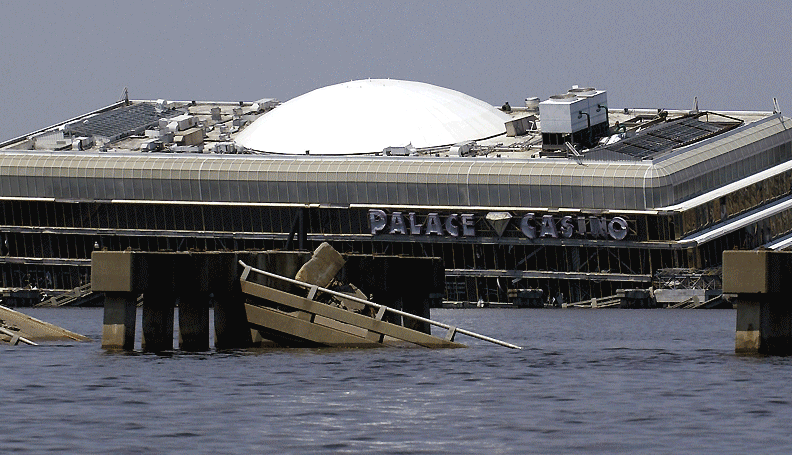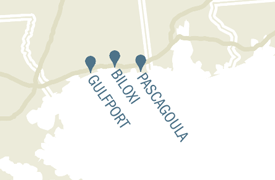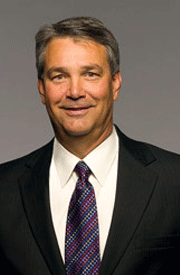
Along the 80-mile Mississippi Gulf coast, upheaval has been constant in recent decades.
Hurricane Camille in 1969 brought destruction on a biblical scale. During the next couple of decades, rebuilding made U.S. Highway 90 an eclectic carnival of giant plastic dinosaurs, putt-putt courses, and mom-and-pop motels mixed with graceful mansions and moss-draped live oaks.
Then came the 1990s and the casinos. State law initially restricted them to "barges"—really, hulking buildings on piers. That limitation changed after Hurricane Katrina barreled ashore 10 years ago. She capsized casinos, destroyed more than 65,000 houses in Mississippi, and generally bulldozed everything in her path.
Taking some big strides back

Ten years on, Mississippi has in some ways made remarkable strides since absorbing the worst of Katrina's winds. In other ways, the road back remains long. Though it's easy from afar to view the Mississippi coast as a unified place of about 400,000 people, that place includes three counties, numerous cities, and communities with differing demographics.
Not surprisingly, those different places are recovering at different rates, points out Ann Carpenter, an adviser in the Atlanta Fed's Community and Economic Development department, who has written extensively about community resilience and specifically about Katrina's aftermath. In general, areas that were more affluent before the storm and those that suffered less storm damage have rebounded more quickly. Insufficient insurance resulted in many people abandoning homes and returning more gradually—if at all, Carpenter says.
"It took 20 or 30 years to fully recover from Camille," she says. "And Katrina caused more damage. It had a higher storm surge and more flooding." Plus, there was more development to be flooded and damaged than there was in 1969. And the barrier islands that buffer the mainland from storms had degraded in the 36 years between the powerful hurricanes.
Further complicating matters, the post-Katrina comeback slammed into two formidable barriers: the Great Recession and the 2010 Gulf oil spill.
The population is all the way back
On the positive side, in 2014, the combined population of the three coastal counties—Hancock, Harrison, and Jackson—finally exceeded its post-Katrina peak, according to the U.S. Census Bureau (see chart 1). Considering that Katrina displaced some 40,000 people from the three counties, that population recovery is no small feat.
In the broadest terms, the economy also shows signs of a nice rebound. Total output—gross domestic product (GDP)—of the Gulfport-Biloxi-Pascagoula metropolitan statistical area grew at a brisk 4 percent in 2013 over 2012 (compared to 1.8 percent growth nationally), according to the most recent local data available from the U.S. Bureau of Economic Analysis (BEA).
That brisk pace underscores a dramatic reversal from not only Katrina but also the Great Recession. After expanding at a heady 6.6 percent in 2005—the year Katrina struck, in late August—the metro GDP dipped severely, to 0.2 percent growth the following year.
In terms of GDP, the Great Recession was a bigger blow to the local economy than Katrina. During and after the downturn, output contracted for three straight years, the biggest decline coming in the last of those years—2011, when the local economy shrank 5.9 percent even as the nation's GDP grew. (To put that 5.9 percent decline in real GDP in perspective, the worst year of the recession dragged the national GDP down 2.7 percent in 2009, according to the BEA.)
Casino business stable
So the more recent bounce-back for the coastal economy comes off a sharp downturn. Gaming has helped. After a posthurricane battering, business has stabilized at the economically important casinos, which generate about $400,000 a day in taxes for state and local governments, according to state records.
While not booming, revenues at the 11 coastal casinos in the past couple years have roughly equaled 2004 levels, according to the Mississippi Gaming Commission. And a new casino with a 300-room hotel is scheduled to open late this year in D'Iberville near Biloxi Bay.
Paychecks have also fattened. Average wages along the coast have risen faster since Katrina than in the decade before the storm and more quickly than they have climbed nationally. In 2014, the most recent data from the U.S. Bureau of Labor Statistics (BLS), the average weekly wage in the three coastal counties was $794, or 9 percent higher than in 2004, after adjusting for inflation.
In many ways, the climb back from Katrina's devastation continues
While there's good news in the region, in many ways the slog back goes on. For example, even though the people are back, not all the jobs are (see chart 2). In 2004, the Gulfport-Biloxi-Pascagoula metropolitan area claimed nonfarm employment of 160,600. Employment exceeded that level in 2008, but the Great Recession took a heavy toll, and through May, employment in 2015 averaged 152,200, according to the BLS.
In particular, one of the biggest sources of jobs before Katrina—the tourism sector—has not returned to full health. Employment in leisure and hospitality has gradually climbed the past couple of years, but this summer was still 16 percent below its 2004 level (see chart 3).
Another of the coast's major employment engines, manufacturing, regained its pre-Katrina muscle in 2008. But apparently more a victim of the economic downturn than the hurricane, factory employment on the coast this year is lower than it was in 2008 and immediately before the hurricane (see chart 4). The sharp decline in 2001 and 2002 was precipitated by a recession and layoffs by shipbuilders, paper mills, and chemical plants.
Finally, the coast's third big jobs generator—government—has held relatively steady (see chart 5). This sector includes a couple of big military installations and NASA's Stennis Space Center. For although casinos garner more attention, the area's military presence is at least as important to the local economy, said Dave Dennis, president of Specialty Contractors & Associates Inc. in Gulfport and a former member of the Atlanta Fed's New Orleans Branch board of directors. Indeed, government in recent years surpassed the leisure and hospitality sector to become the coast's largest single source of employment, according to BLS figures.
Partly to thank for that are Keesler Air Force Base in Biloxi and the U.S. Naval Construction Battalion Center in Gulfport. Together, the two employ about 15,000 people, according to the Harrison County Development Commission.
Costly insurance restrains rebuilding

Dave Dennis
Public-sector employees generally don't build houses, though. And one issue that continues to hamper the Mississippi coast's recovery is the prohibitive cost of wind and flood insurance. Insurance costs, by many accounts, have been the biggest impediment to redevelopment of real estate, especially along the Gulf front.
"It is still the single most important issue to get resolved on this coast in terms of really getting it back up and rolling," Dennis says.
Coastal homeowners' insurance rates across the country have skyrocketed after numerous destructive hurricanes in the early 2000s. In the first five years after Katrina, Mississippi homeowners in the 10-mile band between Interstate 10 and the Gulf of Mexico saw insurance rates double, according to news reports. Rates have kept climbing, though not as rapidly.
A succession of vacant lots and for-sale signs along Highway 90 are stark signs of the sluggish pace of beachfront reconstruction. Of course, expensive insurance is likely not the only factor affecting the real estate market. But home sales volumes in nine post-Katrina years have essentially equaled those of the nine years through 2005, according to the Mississippi Gulf Coast Multiple Listing Service Inc.
It would stand to reason that sales would have increased after the storm, as Katrina destroyed tens of thousands of homes. What's more, on average it has taken 20 days longer to sell a house post-Katrina than before the storm. And after residential building permit issuance in Gulfport-Biloxi-Pascagoula spiked in the three years immediately after the hurricane, it has fallen below 2004 levels in each year since 2008, according to census data.
Maybe the ceiling is lower

James "Pat" Smith
If any place in the Magnolia State can come all the way back, it's probably the coast. It is something of a land apart in a relatively poor, rural state. For the past quarter century, the coast has been buoyed by an optimism unusual for Mississippi, says James "Pat" Smith, author of Hurricane Katrina: The Mississippi Story and history professor emeritus at the University of Southern Mississippi's Gulf Park campus in Long Beach.
Unlike many Mississippians, coastal denizens generally don't fret about losing their educated young people to larger cities, he notes. Census data support that belief, as the three coastal counties are among just 21 of 82 in Mississippi that did not lose population between 2010 and 2014.
"Optimism was hurt by the recession as much as by Hurricane Katrina," the historian Smith says. "There was a lot of fight in people after Katrina. But the recession revealed things about the national environment that left people with questions they didn't have before." He said that the sky is still the limit on the coast but added, "maybe the ceiling is a little lower."
Read the Economy Matters feature on New Orleans 10 years after Hurricane Katrina.




